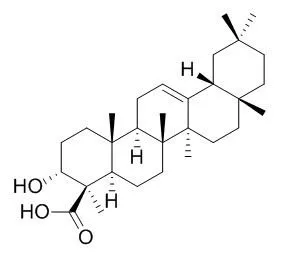| In vivo: |
| Fitoterapia. 2013 Jan;84:99-106. | | In vitro metabolism, permeation, and brain availability of six major boswellic acids from Boswellia serrata gum resins.[Pubmed: 23103296] | Boswellia serrata gum resin extracts (BSE) revealed potent anti-inflammatory actions in preclinical and clinical studies. In 2002 BSE was assigned an orphan drug status by the European Medicines Agency (EMA) for the treatment of peritumoral edema. In the past pharmacological effects of BSE were mainly attributed to 11-keto-β-boswellic acid (KBA) and 3-acetyl-11-keto-β-boswellic acid (AKBA). Therefore pharmacokinetic and pharmacodynamic studies focused mainly on these two boswellic acids (BAs). However, other BAs, like β-boswellic acid (βBA), might also contribute to the anti-inflammatory actions of BSE.
METHODS AND RESULTS:
Here, we determined the metabolic stability, permeability and brain availability of six major BAs, that is, KBA, AKBA, βBA, 3-acetyl-β-boswellic acid (AβBA), α-boswellic acid (αBA), and 3-acetyl-α-boswellic acid (AαBA). For permeability studies, the Caco-2 model was adapted to physiological conditions by the addition of bovine serum albumin (BSA) to the basolateral side and the use of modified fasted state simulated intestinal fluid (FaSSIF) on the apical side. Under these conditions the four BAs lacking the 11-keto moiety revealed moderate permeability. Furthermore the permeability of AKBA and KBA was improved compared to earlier studies. In contrast to Aα- and AβBA, βBA and αBA were intensively metabolized after incubation with human and rat liver microsomes. Finally, the availability of all six major BAs could be confirmed in rat brain 8h after oral administration of 240mg/kg BSE to rats showing mean concentrations of 11.6ng/g for KBA, 37.5ng/g for AKBA, 485.1ng/g for αBA, 1066.6ng/g for βBA, 43.0ng/g for AαBA and 163.7ng/g for AβBA. | | J. Pharm. Pharmacol., 2016, 68(4):514-22. | | Alpha-boswellic acid protects against ethanol-induced gastric injury in rats: involvement of nuclear factor erythroid-2-related factor 2/heme oxygenase-1 pathway.[Pubmed: 26992040] | The purpose of this study was to assess the gastroprotective properties of alpha-Boswellic acid (α-BA), a pentacyclic triterpene compound from extracts of Frankincense.
METHODS AND RESULTS:
The gastroprotection of α-BA was assessed with ethanol-induced gastric lesions model, by histopathological assessment and measuring gastric juice acidity (pH), gastric wall mucus (GWM), prostaglandins E2 (PGE-2), membrane lipids peroxidation (MDA), superoxide dismutase (SOD) activity, catalase (CAT) activity and amount of nitric oxide (NO). The gastroprotective effects of α-BA through the nuclear factor erythroid-2-related factor 2/heme oxygenase-1 (Nrf2/HO-1) anti-oxidative pathway were presented and measured by immunohistochemistry and Western blot.
The results showed that α-BA reduced injuries associated with the administration of ethanol, gastric juice acidity and the formation of MDA and increased CAT activity and SOD activity and the level of NO and PGE-2 in a dose-depended manner. The expression of both Nrf2 and HO-1 was significantly increased in the group treated with 200 mg/kg α-BA, which suggested that activation of the Nrf2/HO-1 pathway might be critical in α-BA's prevention of gastric ulcers.
CONCLUSIONS:
These findings demonstrate that α-BA decreases oxidative stress and that the Nrf2/HO-1 pathway might play a role in the gastroprotective action of α-BA in ethanol-induced gastric injury in rats. |
|






 Cell. 2018 Jan 11;172(1-2):249-261.e12. doi: 10.1016/j.cell.2017.12.019.IF=36.216(2019)
Cell. 2018 Jan 11;172(1-2):249-261.e12. doi: 10.1016/j.cell.2017.12.019.IF=36.216(2019) Cell Metab. 2020 Mar 3;31(3):534-548.e5. doi: 10.1016/j.cmet.2020.01.002.IF=22.415(2019)
Cell Metab. 2020 Mar 3;31(3):534-548.e5. doi: 10.1016/j.cmet.2020.01.002.IF=22.415(2019) Mol Cell. 2017 Nov 16;68(4):673-685.e6. doi: 10.1016/j.molcel.2017.10.022.IF=14.548(2019)
Mol Cell. 2017 Nov 16;68(4):673-685.e6. doi: 10.1016/j.molcel.2017.10.022.IF=14.548(2019)